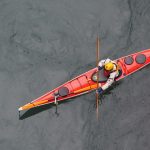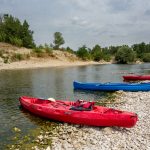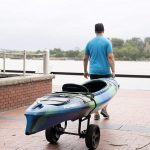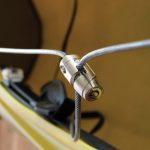So you’ve got your kayak and a bag of gear waiting to get out on the water. Awesome, now let's find a solution for transporting it.
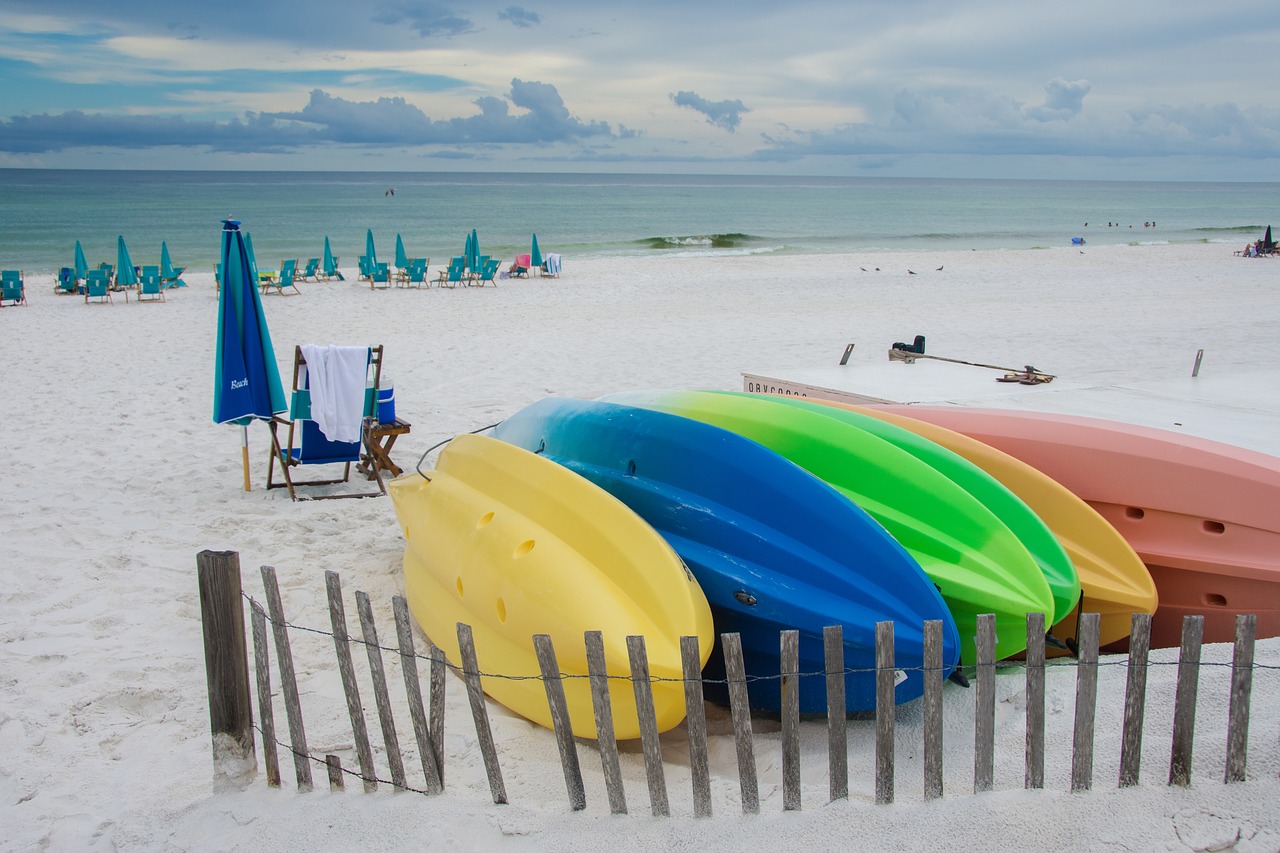
Our kayaks and paddling gear spends much more time in storage than it does out on the water, and it’s important that we look after it while we’re not using it just as well as we would while we’re using it.
Storing Your Kayak
Kayaks are pretty big and bulky, unless you’ve gone for the inflatable option. They’re not the easiest thing to store and often we are limited on space and options.
However, incorrect storage is just as bad for a kayak as dragging it over rocks and bouncing it down the road, so it’s not something you’d want to neglect.
There’s a few options to explore with storing our kayaks, so that whatever space you have can be maximised to keep your kayak going for years, but before we get into that, there’s a few basic rules that apply to kayak storage.
Empty Your Kayak
Remember to take out all your accessories and spares. These may not do damage to the boat, but keeping them in your boat is unlikely to be very good for them. These things need to be cleaned and have a chance to dry too.
Clean Your Kayak
Make sure your kayak is cleaned off before you put it in for storage, including dirt, stones, plants and salt water. All of these can do damage or corrode the kayaks over time, so give it a spray down with a hose before you put it away.
If you can, leave it to air and dry out once you’ve cleaned it, and make sure any water is out of it.
Mend Anything That’s Broken
It can be very tempting to leave it for the time being, but if you do that it’s almost guaranteed that the next time you go kayaking you’ll suddenly remember that you’ve not fixed your boat.
If a rope snaps, or a foot peg is stiff, fix it before you put it away, that way it’s ready to go next time.
Storing a Kayak Indoors or Outside
Storing a Kayak Indoors
If you have the space to store a kayak inside then your boat will thank you in the long run. Make sure it’s fully dry before bringing it inside. If you’re storing your kayak in a shed or outbuilding, make sure that it’s away from anywhere damp and that no animals can get into it and nest.
Be aware of what else is around your kayak, too. Avoid areas with chemicals or sharp objects, or anywhere you’re going to need access to regularly.
Storing a Kayak Outside
It’s not the end of the world if you have to store your kayak outside, but there’s a few things to watch out for.
Sunlight and the UV that comes with it can damage a kayak, so try to find shade or cover your kayak with a tarp or similar.
Equally, persistent damp can damage the outfitting in a kayak, and freeze-thaw can cause damage. Try to dry your kayak and then cover it if where you are is prone to snow or freezing.
These coverings work better if you suspend a tarp separate to the kayak, rather than wrapping the boat. Allowing boats to breathe lets them stay dry and reduces the chance of mould growing on the kayak.
Animals love to get into kayaks and nest through winter. Covering your kayak or storing it off the ground can help prevent this.
Watch out for pipes dripping on boats, or household vents which can get hot.
Options for Storing Your Kayak Outside
Storing a Kayak on the Ground
This is never the ideal option and we should avoid this unless it’s the only option available. Long-term storage on the ground can warp the kayak’s hull and affect how the boat paddles. It also leaves the boat open to damp, and critters can use it as a nest.
If you do have to store your kayak on the ground, consider covering it with a tarp or similar. Take out any extra gear and don’t stack kayaks; the extra weight can cause damage. Softer ground like grass or wood chips is better than concrete.
Storing a Kayak on a Rack
Kayak racks are usually made of metal or wood, and are an easy way to lift your boat off the ground. By just making a simple racking system from a couple of blocks of wood, you can lift your boat off the floor and protect the hull.
Racks can be simple, for one kayak, or extravagant, fitting multiple boats.
Make sure your rack isn’t too high for you to load and unload. It needs to be stable and secure, otherwise it might come crashing down in the wind.
Be sure the arms of your rack are appropriate for your kayak. If they’re too far apart, your boat may just not reach, but too close together and the weight of either end may cause the boat to become unstable, or worse to warp over time.
Consider your rack materials. If they’re sharp, or likely to heat up or cool down easily, cover them in old carpet or thick plastic piping to protect your kayak.
It is always a good idea to make some kind of cover over your rack to protect your kayak from the sun and precipitation.
Storing a Kayak Suspended
This is a great option for getting your boat out of the way if you have a tall building. You can either buy a system or rig up your own with a few pulleys, and haul your boat towards the ceiling where it won’t be in the way.
It’s great, but as with any system, there’s things to be certain of before you haul your boat up.
Pressure Points
Storing your boat for a long time, up high, can put a lot of pressure on a small area. Try to distribute the weight evenly and use wide webbing straps, or padded stirrup-type cradles to support the kayak in the rack.
You may want to tie the boat into the cradles, for extra security, but don’t strap it down like you would on your roof rack; over time this pressure can deform and damage a kayak.
How Secure Is Your System?
The last thing you want is for your boat to come crashing down. From that height, your boat may end up in several pieces, or at least one severely damaged piece.
Make sure your system is secure and unlikely to fail, maybe consider a backup system.
This also goes for hauling and lowering the boat; how easy is it to lift and lower the kayak from the raised position? If it’s too difficult, look at alternative systems so you don’t drop your boat.
How Accessible Is It?
If you want to go out for a quick paddle, how easy is it to get your kayak down?
Sometimes it can seem more hassle than it’s worth to lower a kayak and get it out to the water. Make sure it’s easy enough to get to your boat when you want to use it.
It’s also worth making sure you have all your gear out of it before you haul it up and that you have dried the boat properly. It can be worth putting a cockpit cover on while in storage, to avoid anything nesting in your kayak.
Protection Against Theft
Is your kayak secured against thieves?
A simple bike lock, or kayak cable, can be enough to protect your boat. It might seem obvious, but it’s not always at the forefront of our mind, and kayaks regularly go missing from gardens, roof racks and sheds.
How To Care For Your Kayak
As we’ve said above, most kayak care comes from proper storage and cleaning our boats before we put them away, but there’s a few things we can do for our boats, too.
Be sure to regularly check the hull and try to catch any scrapes before they become too deep or split. If boats do split, they can be welded back together, either by closing the hole or adding more plastic to the area. They may never be as strong as they once were, but they are still usable and watertight.
Ropes, rudders and ratchets. Anything that moves, basically, should be checked every time you get on and off the water. Springs wear quickly and can rust, so they should be allowed to dry properly every time you get off the water.
Bolts are usually fitted with sealed washers, which may need to be replaced from time to time. Keep an eye on these and replace them before they start to leak.
Outfitting can wear over time, so check it regularly to make sure it still fits you as it should and hasn’t moved, and that it’s in good condition.
UV damage is the most common cause of issues on kayaks. Try to store them out of direct sunlight where possible.
How to Care For Your Gear
Like kayaks, all gear is susceptible to UV damage. It should be stored out of direct sunlight and should always be dried and stored in a cool, dry place.
On dry suits or similar, latex seals can perish easily if they aren’t cared for properly. These can be replaced if they do split, but that shouldn’t be common if they’re properly cared for. Sharp nails, earrings etc… can cause these to split as you put them on.
Most waterproof equipment can be repaired. Seams can be re-glued and holes patched. That said, you do reach a point with gear where it is best to just replace it.
Salt water can destroy your gear quickly, so it’s important to wash your gear after being in the sea. In fact, just wash your gear after kayaking.
Check the inside of your kayak for sharp areas, and avoid walking through undergrowth in your gear; thorns can pierce gear and rocks can be abrasive.
At the end of the day, your gear is there to be used, but we can take steps to keep it working for as long as possible.
PFDs perish at the same rate as other gear and are the most important piece of equipment. If you feel your PFD is not floating as it should, consider replacing it while you can.
Care For Yourself
The most important part of any kayak is the paddler. Look after yourself and you’ll be able to kayak for a long time.
Warm up before getting on the water, and start gently until your muscles are in shape for the day.
A common cause of injury is lifting and moving boats. We often do this before we have thought about warming up for paddling. Kayaks are heavy and can cause serious damage to us. Carry boats in pairs, and lift with bent knees and a straight back.
If you’re an infrequent kayaker, consider some other form of exercise to keep kayak fit; weights, running, cycling or hiking are good options for retaining some fitness so you’re ready to kayak. If it’s been a while since you’ve kayaked, don’t expect too much, too soon, from your body.
Get out and enjoy your time on the water, but look after yourself.





